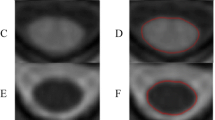Abstract.
Background: The spinal cord is a common site of involvement in multiple sclerosis (MS) where pathology contributes substantially to locomotor disability. Previous studies have demonstrated significant correlations between clinical disability and cervical cord atrophy, but not with cord T2 lesion load. We evaluate cervical cord pathology using, for the first time, quantitative T1 relaxation time (T1), which shows histopathological specificity for tissue damage in the cerebral white matter. Method: Cervical cord T1 was compared in 15 MS patients [8 relapsing-remitting (RR), 7 secondary progressive (SP)] and 6 healthy controls, and related to normalised upper cervical cord area (UCCa), cerebral white matter T1, T2 lesion load and disability measures including the Expanded Disability Status Scale (EDSS), Ambulation index (AI) and timed 25-foot walk. T1 maps of the brain and cervical cord were acquired using a high-resolution, 3-dimensional fast low-angle shot sequence. Dual-echo sequences were also obtained. Results: Median cervical cord T1 [mean (standard deviation)] was significantly greater in RR [854 [28] ms] (p = 0.0006) and SP patients [927 [67] ms] (p < 0.0001) compared with controls [888 [61] ms], and in SP vs. RR patients (p = 0.002). In the overall patient cohort, it correlated significantly with median cerebral white matter T1 (r = 0.7, p = 0.0046), UCCa (r = −0.87, p < 0.0001), but not T2 lesion loads. Both median cervical cord T1 and UCCa (respectively) correlated significantly with the EDSS (r = 0.55, p = 0.03; r = −0.54, p = 0.04), AI (r = 0.77, p = 0.001; r = −0.60, p = 0.02) and timed 25-foot walk (r = 0.56, p = 0.03; r = −0.55, p = 0.04). Conclusion: Cervical cord T1 distinguishes between MS subgroups and could also prove a useful surrogate outcome measure in MS. The relation of cervical cord T1 to cerebral white matter T1 suggests that cord pathology may be influenced by tissue damage upstream.
Similar content being viewed by others
Author information
Authors and Affiliations
Additional information
Received: 13 June 2002, Received in revised form: 9 October 2002, Accepted: 18 October 2002
Supported by a research grant from The University of Nottingham.
Correspondence to Lalitha Vaithianathar
Rights and permissions
About this article
Cite this article
Vaithianathar, L., Tench, C., Morgan, P. et al. Magnetic resonance imaging of the cervical spinal cord in multiple sclerosis . J Neurol 250, 307–315 (2003). https://doi.org/10.1007/s00415-003-1001-8
Issue Date:
DOI: https://doi.org/10.1007/s00415-003-1001-8




